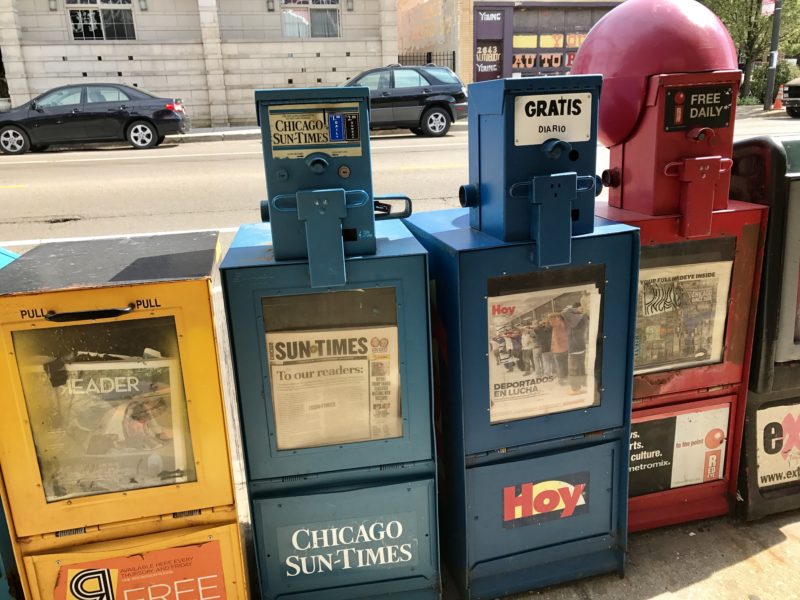WHEN THE CHICAGO SUN-TIMES reported on plans for its acquisition by the Chicago Tribune’s parent company, Tronc, media observers may have been tempted to throw back a cold one and prepare for the inevitable wake. Under preliminary terms of the deal, Tronc would purchase the Sun-Times and the alternative weekly Chicago Reader from Wrapports LLC.
Tronc would own and operate the Sun-Times as a separate entity, according to the Sun-Times’ coverage. However, with few exceptions, the sale of one newspaper to another in its market is usually a sign that Pac-Man is closing in on the ghost.
The game isn’t over just yet. On May 16, the Sun-Times published a full-page advertisement soliciting other buyers. (The sale of the Sun-Times to the Tribune’s owner would require Justice Department approval.) Politico reported Monday that two other buyers have come forward, which could potentially delay Tronc’s acquisition or else scuttle the deal entirely. Chicago News Guild consultant David Roeder mentioned the other interested parties to Natasha Korecki, a former Sun-Times political reporter who now writes the Illinois Playbook, but he did not name them, and it’s too early to know how serious those interests are.
Sun-Times publisher Jim Kirk struck an optimistic note in a front-page letter to readers, calling the pending sale of the paper to Tronc “the best path for the Sun-Times to succeed long-term.” He wrote that the deal makes sure “that the independent newsroom would remain.”
But it’s tough to imagine a single owner would sustain two distinct dailies in Chicago indefinitely—a concern raised in a recent Chicago News Guild ad in Crain’s Chicago Business. The acquisition, said the ad, imperils “independent journalism” as well as “our publications and jobs.” The guild also provided a statement to Chicago media blogger Robert Feder in which a Sun-Times employee said, “We are concerned that, whatever its intentions, the Tribune will have no long-term incentive to keep these publications going once it gets control of them.”
ICYMI: Help us track job losses in local newsrooms
It’s also tough to imagine who else might be interested in buying the Sun-Times. The day the paper published the story about its expected sale, I hung out at a 7-Eleven in the Lincoln Park neighborhood. I watched a dozen people pause at the newsstand to look at the front page, where a headline screamed, “To our readers.” I spent 20 or so minutes there, and only one person bought the paper: me. Sentiment is rarely good for the bottom line— although, apparently, the same can’t be said about baseball.

“If I were working at the Sun-Times, I better start looking for a job in a couple of years,” says George Sylvie, an associate journalism professor at the University of Texas at Austin, noting that the sale only buys the Sun-Times time and is likely not sustainable for very long. “The Sun-Times is a good paper. Don’t get me wrong. It still provides a different product from the Tribune. But, honestly, the [commodification] of news now makes that product not very valuable to a lot of people.”
Kirk tells CJR he is confident that keeping the two papers separate will ensure the Sun-Times’s survival. The Sun-Times “has a unique audience and style, and it continues to be a must-read,” he says. “From a business perspective, it remains a strong brand with a loyal audience. And the city is a big and diverse market that is well served by two voices, as long as they are managed separately.”
When the Daily News was taken over and merged into the same family as the Inquirer, it created this really intense emotion from people who worked at the Daily News.
THE PROPOSED CHICAGO ARRANGEMENT—a single owner, two separate newsrooms—has worked elsewhere, with caveats. The Philadelphia Inquirer and the Philadelphia Daily News have been co-owned since 1957, though each has a distinct readership; the Inquirer, like the Chicago Tribune, has a strong suburban presence.
When George Miller, now an associate professor of journalism at Temple University, joined the Philadelphia Daily News as a photographer in 1994, the newsroom was still separate and culturally distinct from the Inquirer.
“It worked for a long time when they were two independent editorial operations,” says Miller, who was also a city desk reporter during his 11 years at the Daily News.
It was a very competitive environment. There was always the feeling that the publisher favored the Inquirer. We were the adopted child nobody wanted to take care of. And it was sort of true. For a long time the Daily News didn’t have a lot of support for the business.
But there was also an advantage to being at the smaller paper, Miller says.
“The beautiful thing was that since day one, when the Daily News was taken over and merged into the same family as the Inquirer, it created this really intense emotion from people who worked at the Daily News,” he says. Daily News staffers felt like they were always in danger of losing their jobs because they worked at the underdog paper. “And because they were danger, they had to go out and kick ass,” Miller says.
The two papers merged newsrooms in 2015. Both publications, as well as Philly.com, are now owned by the Philadelphia Media Network. Last year, the network became part of the Lenfest Institute for Journalism, a nonprofit whose endowment may soon top $100 million.
“They have survived,” Miller says of the Daily News, “and they haven’t survived.”
Some would say the beginning of the end for the Sun-Times has been in the works for 10 years. It’s probably at the point where there’s nobody that wants to buy it except the Tribune.
AT THE CENTER OF THE CHICAGO DEAL is Michael Ferro, a local tech baron. Ferro is the majority owner of Tronc, formerly Tribune Publishing, which also owns the Los Angeles Times, the Baltimore Sun, The San Diego Union-Tribune and others.
In 2011, Ferro (through Wrapports LLC) bought the Chicago Sun-Times. Last year, he paid $44 million to buy a 16.5 percent stake in Tribune Publishing, making him the largest shareholder in the renamed Tronc. To avoid a conflict of interest, he donated his share of the Sun-Times to a charitable trust.
Ferro intends to “save journalism.” Whether he can save the Sun-Times is another matter. Wrapports sold its suburban operations to the Tribune in 2014, and the two papers share a printing and distribution agreement.
“Some would say the beginning of the end for the Sun-Times has been in the works for 10 years,” says Rick Edmonds, a media business analyst for the Poynter Institute. “It’s probably at the point where there’s nobody that wants to buy it except the Tribune.”
On the day that Kirk wrote his letter to readers, the Sun-Times published a full-page advertisement announcing its non-binding letter of intent with Tronc. The Justice Department’s antitrust division launched an investigation—protocol when two competitors intend to merge. Last year, the Justice Department filed suit to block Tribune Publishing’s attempted purchase of the Orange County Register and Riverside Press Enterprise on antitrust grounds. The Orange County Register’s bankrupt owner sold to another company, leaving Tronc with only the Los Angeles Times and The San Diego Union Tribune in the southern California market.*
Kirk acknowledged to readers that the Sun-Times faces “enormous challenges.” But to keep a second media voice in Chicago “alive and thriving,” the paper must find an owner with deeper pockets and a national platform to help promote it. In 2014, the Sun-Times tried unsuccessfully to create its own national network, but ended up making a digital mess of its website.
‘In a number of joint operating agreements,’ wrote Paul Farhi for the American Journalism Review, ‘publishers have mutually decided it’s better for their bottom lines, if not for their readers, if one of the partners dies.’
SINCE THE NEWSPAPER PRESERVATION ACT OF 1970, the US government has exempted papers from certain antitrust provisions, allowing two publications in a single market to form a joint operating agreement. However, in the past two decades, newspaper JOAs have largely been inadequate protection against the market forces of declining readership and advertising sales. At its peak, the country had nearly 30 JOAs. There are now fewer than 10, in cities including Detroit, Las Vegas, Salt Lake City, Tucson, New York, Charleston, West Virginia, and Fort Wayne, Indiana.
“The cause of death for many JOA papers over the past 15 years seems more closely akin to homicide than advanced age,” wrote Washington Post media reporter Paul Farhi in a 1999 American Journalism Review story. “In a number of JOAs, publishers have mutually decided it’s better for their bottom lines, if not for their readers, if one of the partners dies.”
Fort Wayne, which has a population of about 250,000, is an exception. The family-owned Journal Gazette and the Ogden Newspapers-owned News-Sentinel have so far managed to pull off what bigger cities with larger readerships have not. “The town has two newspapers, and digital readership at the Journal Gazette has increased,” says Julie Inskeep, president and publisher of the Journal Gazette. “Certainly our print circulation has declined, and we expect that trend to continue. But we have never had more readers than we do now. I take pride in that.”
Inskeep attributes the two-newspaper city to the joint operating agreement. “It is a unique situation, making us both partners and competitors,” she says.
In a blog post this week for Public Narrative, a Chicago-based community journalism organization, Susy Schultz argued that partnership is more important than competition. After all, both newsrooms operate by the same professional standards. Both newsrooms are filled with talented journalists. Why do they need to compete?
“Survival is going to take more than healthy competition,” wrote Schultz, Public Narrative’s president. “We need innovation, bold innovation. These newspapers have to step outside what is comfortable, what is status quo and move the work forward. And in this case, innovation just might be defined by cooperation.” The Sun-Times is not negotiating a joint operating agreement with the Tribune.
THE SUN-TIMES/TRIBUNE DEAL also raises questions about the editorial future of the pioneering Chicago Reader, whose fate is tied to the Sun-Times through Wrapports. (The alt-weekly Missoula Independent in Montana faces a similar question; Lee Enterprises, which owns The Missoulian daily newspaper, purchased the Independent last month, but plans to maintain separate newsrooms.)
“What does this news mean for the Reader?” asked that paper’s media critic, Michael Miner. In his coverage of the pending Chicago sale, Miner noted that the Sun-Times’ Kirk did not mention the award-winning Reader or its newly unionized staff, which is in the middle of negotiating its first contract with Wrapports and has authorized a strike over wages. For now, Miner’s question has no answer.
The Justice Department is expected to approve the sale of the Wrapport holdings to Tronc. “The Justice antitrust division seems to sort of be aware that the business is changing, and these are tougher times,” Edmonds says.
And if the Justice Department nixes the deal, leaving the two dailies to go their separate ways?
Darryl Holliday, who started his career at the Sun-Times and now is editorial director at the City Bureau, a civic journalism nonprofit he co-founded in 2015, isn’t optimistic.
“The Sun-Times might fold without a merger,” he says. “And I think it will fold with a merger anyway.”
*An earlier version of this story misstated the number of newspapers Tronc owns in southern California.
TRENDING: We tested paywalls at NYTimes, WSJ& WashPo and more. All of them were pretty leaky, except one.
Jackie Spinner is CJR’s correspondent for Illinois, Indiana, Ohio, and Wisconsin. She is an associate journalism professor at Columbia College Chicago and a former staff writer for The Washington Post. Follow her on Twitter @jackiespinner.

